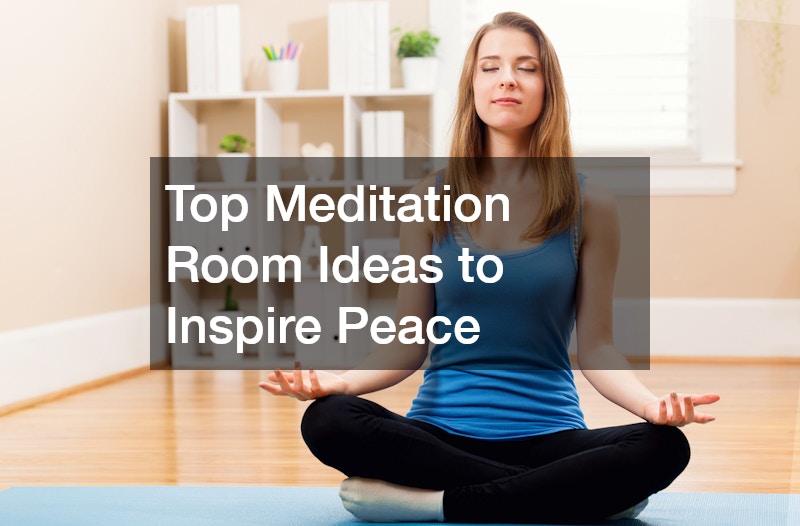Serenity at Home: Top Meditation Room Ideas to Inspire Peace
Introduction
Having a dedicated meditation room in your home can significantly enhance your mindfulness practice. Such a space helps you disconnect from the chaos of daily life, offering a tranquil refuge to focus inward. A meditation room not only fosters peace but also contributes to your overall well-being. The environment, free from external distractions, becomes a sanctuary for mental clarity and emotional healing. With meditation room ideas for home, you can customize a space that resonates with your personal style and needs, paving the way for a consistent and fulfilling meditation practice.
Choosing the Right Space

Finding the perfect location for your meditation room is crucial in setting the tone for your practice. Here are several key considerations to ensure you choose the best spot in your home:
1.1 Location Matters
- Select a Quiet Area: Opt for a room or corner that is away from high-traffic zones and noisy appliances. This might be a spare bedroom, a nook in the living room, or even a garden shed converted into a meditation space. The quieter the environment, the easier it will be to focus.
- Avoid Distractions: Ensure that your meditation space is not in the same area where you often engage in work, watch TV, or handle household chores. This separation helps create a mental boundary that signals your mind it’s time to meditate.
1.2 Embrace Natural Light
- Natural Light: Choosing a room with ample natural light can enhance the mood and ambiance, promoting relaxation and positivity. Sunlight is known to improve mood and enhance overall well-being. If possible, position your meditation space near a window or in a sunlit room.
- Lighting Options: If natural light is limited, consider incorporating soft lighting through lamps or LED strips. Dimmer switches can be an excellent investment for controlling brightness and creating the right atmosphere.
1.3 Privacy and Comfort
- Ensure Privacy: Privacy is another factor to consider, ensuring your meditation sessions remain undisturbed by household activities. You might use curtains, room dividers, or even soundproofing materials if needed.
- Comfortable Temperature: Ensure the space can be kept at a comfortable temperature, as an overly warm or cold environment can distract from your practice. Consider using fans, heaters, or air conditioning as needed.
These considerations are vital in creating a personal oasis where peace and focus are in abundance, setting a solid foundation for your meditation practice.
Creating a Calming Atmosphere
The decor of your meditation room plays a significant role in setting a calming atmosphere. To cultivate a peaceful environment, consider the following elements:
2.1 Color Schemes and Decor
- Choose Soft Color Palettes: Colors greatly affect mood. Soft shades of blues, greens, and neutrals can create a soothing environment conducive to mindfulness. Research shows that certain colors can evoke feelings of tranquility and relaxation.
- Use Textures: Incorporate various textures to add layers of comfort and warmth. Soft rugs, plush cushions, and cozy blankets create an inviting feel. A thick rug can also help absorb sound, adding to the serenity of the space.
- Add Personal Touches: Incorporate meaningful artwork, photos, or decorations that inspire peace. Consider hanging serene landscapes or calming abstract art that resonates with your mindfulness journey.
2.2 Sensory Enhancements
- Sound Elements: Incorporate ambient sound through nature echoes or soothing music to enhance the sensory experience during meditation. Sound machines or speakers can play calming music or nature sounds, such as rain, ocean waves, or forest sounds, enhancing your meditation experience.
- Lighting Options: Choose lighting that contributes to relaxation. Candles can provide soft, flickering light and create a calming ambiance. Consider using LED candles for safety or Himalayan salt lamps, which offer a warm glow and purported air-purifying benefits.
- Aromatherapy: Utilizing diffusers with essential oils, such as lavender, chamomile, or sandalwood, promotes relaxation and calm. You might also consider incense sticks, which have been used for centuries to enhance meditation practices. Ensure that the scents resonate with you personally to create a more profound effect.
Essential Elements for a Meditation Room
Creating a meditation room is not just about aesthetics; it’s also about functionality and comfort. Here are the essential elements that every meditation space should include:
3.1 Meditation Cushions and Mats
- Comfort is Key: When engaging in meditation, comfort is paramount. Cushions and mats are indispensable in your space. Choose materials that provide ample support and cushioning, allowing you to maintain focus without physical discomfort.
- Different Styles: Look for meditation cushions like zafus or zabutons, which are designed specifically for seated meditation. A yoga mat can also work if you prefer to meditate lying down or engaging in gentle stretches before your practice.
3.2 Sound and Music
- Ambient Sound: Integrating sound can significantly enhance your meditation experience. Explore options like nature sound machines, which can produce rain, ocean waves, or forest sounds. Alternatively, consider soft instrumental music playlists available on platforms like Spotify or YouTube.
- Meditation Music: Music can help deepen your meditation practice. Look for tracks that promote relaxation and mindfulness. You can find various playlists tailored to different types of meditation, from guided sessions to background music.
3.3 Lighting Choices
- Natural vs. Artificial: A balance of both is important. While natural light can boost your mood, having control over artificial light can help you create a soothing environment in the evening. Dimmable fixtures allow you to adjust the light to your preference.
- Candles and String Lights: Candles can set a peaceful ambiance and make the space feel sacred. String lights can also add a whimsical touch and provide soft lighting. Just ensure any candles are placed safely, away from flammable materials.
3.4 Aromatherapy
- Essential Oils: The use of essential oils can elevate your meditation experience. Scents like lavender promote relaxation, while citrus scents like lemon can uplift your mood. Invest in a high-quality diffuser and experiment with blends to find what works best for you.
- Scented Candles: If you prefer not to use diffusers, scented candles can also create a calming aroma. Choose natural wax candles with essential oil fragrances to enhance the ambiance.
Minimalism and Decluttering
Minimalism emphasizes clarity by removing distractions, an integral concept for a productive meditation space. A clutter-free environment helps minimize mental distractions, enhancing the effectiveness of your meditation sessions.
4.1 The Power of Minimalism
- Simplifying Your Space: Decluttering should not only eliminate excess items but also shape a space that echoes simplicity and function. Keep only those items that contribute to your meditation practice.
- Mindful Selection: As you declutter, ask yourself if each item in the space adds value to your meditation. If not, consider removing it. This will help create an environment where your mind can settle into stillness.
4.2 Regular Maintenance
- Routine Cleaning: A regular cleaning schedule keeps your meditation room inviting and free of distractions. This can be a simple weekly dusting and vacuuming to ensure the space feels fresh.
- Refreshing Your Decor: Refreshing scents and rearranging decor prevents stagnation, keeping your environment inspiring. Change out the artwork, rotate cushions, or introduce new elements every few months to keep your space dynamic.
By adopting a minimalist approach, your meditation room can become a beacon of mental clarity and peace, making it easier to enter a meditative state.
Incorporating Nature

Introducing natural elements into your meditation room can significantly enhance the sense of serenity. Nature has a calming effect on the mind and body, making it an excellent addition to your meditation practice.
5.1 Indoor Plants
- Choosing the Right Plants: Indoor plants like snake plants, peace lilies, or bamboo are excellent choices. They purify the air and bring a touch of nature indoors, enhancing the ambiance of your meditation space.
- Caring for Your Plants: Ensure you understand the care requirements for your chosen plants to keep them thriving. Regular watering and appropriate lighting will keep your plants healthy, contributing to a peaceful environment.
5.2 Natural Elements
- Materials: Incorporate materials such as wood and stone in your decor. Wooden shelves, stone accents, or even a small water feature can add an organic touch to your meditation room.
- Nature-Inspired Decor: Consider artwork or decorative items that feature natural themes, like landscapes, trees, or ocean scenes. These elements can help you feel more connected to the earth while you meditate.
5.3 Outdoor Meditation Options
- Utilizing Outdoor Space: If you have a garden or balcony, consider setting up an outdoor meditation area. Nature sounds, fresh air, and the feeling of grass or soil beneath you can enhance your practice.
- Creating a Zen Garden: A small outdoor zen garden can provide a peaceful space for meditation and contemplation. Incorporate rocks, sand, and plants to create a serene setting.
Collectively, these elements bring harmony and enhance the meditative experience by creating a nature-inspired ambiance that invites calm and tranquility.
Personalizing Your Space
Your meditation room should reflect your personal journey and preferences, serving as a canvas for self-expression. Here are some ways to infuse your personality into the space:
6.1 Adding Personal Touches
- Display Meaningful Items: Family heirlooms, travel souvenirs, or gifts can add layers of personal significance and evoke positive memories, contributing to a warm and inviting space.
- Custom Art: Create or commission artwork that speaks to your meditation journey. This could be a piece that represents a mantra, a symbol of peace, or something that inspires you.
6.2 Inspirational Quotes
- Incorporate Affirmations: Use wall art or decorative items to display quotes or affirmations that inspire you. This not only enhances the decor but also serves as a reminder of your intentions.
- Vision Boards: Create a vision board with images and words that resonate with your goals and aspirations. This can motivate and uplift you each time you enter your meditation space.
6.3 Adaptive Elements
- Flexible Space: If you enjoy varied meditation practices (like yoga or tai chi), ensure the space can adapt. Use foldable mats, adjustable lighting, and movable furniture to create a versatile area.
- Seasonal Decor: Consider changing decor elements with the seasons. This can keep the space feeling fresh and relevant, enhancing your motivation to meditate.
By personalizing your meditation room, you create a unique sanctuary that resonates with your inner self and reflects your journey, making it more inviting and enjoyable.
Integrating Technology Mindfully
While the goal is often to disconnect from technology during meditation, certain tech tools can enhance your practice. The key is to integrate them mindfully and avoid overreliance.
7.1 Meditation Apps
- Guided Meditations: Many meditation apps offer guided sessions, which can be particularly helpful for beginners. Explore options like Headspace, Calm, or Insight Timer to find what resonates with you.
- Progress Tracking: Some apps provide tracking features that allow you to monitor your meditation frequency and progress, helping to keep you motivated.
7.2 Sound Technology
- Quality Speakers: Investing in good quality speakers can enhance your listening experience. Whether you choose calming playlists or nature sounds, quality sound will enrich your meditation sessions.
- Noise-Canceling Headphones: If you’re in a noisy environment, noise-canceling headphones can help you maintain focus by blocking out distractions. This can be especially beneficial if you share your space with others.
7.3 Meditation Equipment
- Smart Diffusers: Some diffusers allow you to control the scent and mist levels through your smartphone, ensuring you have the ideal ambiance for meditation.
- Smart Lighting: Using smart bulbs can help create the perfect lighting conditions based on the time of day or your mood, adding another layer of convenience to your meditation practice.
Integrating technology can enhance your meditation experience if approached mindfully. By focusing on enhancing the quality of your practice while minimizing distractions, you can cultivate a more profound sense of peace and tranquility.
Conclusion
Creating a dedicated meditation room can transform your home into a sanctuary of peace and serenity. By choosing the right location, cultivating a calming atmosphere, incorporating essential elements, embracing minimalism, and personalizing the space, you can develop a meditation practice that is both fulfilling and rewarding. Remember, your meditation room should reflect your unique style and preferences, making it a personal refuge that encourages mindfulness and tranquility. With these meditation room ideas, you’re well on your way to nurturing your practice and enhancing your overall well-being.
Ready to create your own meditation space? Start small—choose a corner, invest in a meditation cushion, and add a few calming elements. Over time, you can transform it into a sanctuary that supports your mindfulness journey. Share your meditation room ideas and experiences with friends and family, inspiring them to create their own peaceful spaces. Remember, the journey to serenity begins at home.
